Retrieving Water Turbidity in Araucanian Lakes (South-Central Chile) Based on Multispectral Landsat Imagery
Abstract
:1. Introduction
2. Materials and Methods
2.1. Study Area
2.2. Sampling Measurements
- 1.
- Morphology of the lake.
- 2.
- Presence of tributaries (away from their influence).
- 3.
- Presence of industrial effluents or urban discharges.
- 4.
- Depth.
2.3. Image Acquisition and Processing
2.4. Standardization of Existing Water Clarity Measurements
2.5. Band Combinations, and Turbidity Index
2.6. Empirical Models and Validation
2.7. Water Clarity and Meteorological Conditions
3. Results
3.1. Behavior In Situ Limnology Parameters at Sampling Stations in the Study Lakes
3.2. In Situ Secchi Disk Depth (SDD) Measurements into Correlative Nephelometric Turbidity Units (NTU)
3.3. Empirical Models and Validation
3.4. Spatial Distribution of Estimated Turbidity in Araucanian Lakes
3.5. Influence of Meteorological Conditions in the Study Area
4. Discussion
5. Conclusions
Supplementary Materials
Author Contributions
Funding
Institutional Review Board Statement
Informed Consent Statement
Data Availability Statement
Acknowledgments
Conflicts of Interest
References
- Wetzel, R. Limnology: Lake and river ecosystems; Press, A., Ed.; Elsevier: Amsterdam, The Netherlands, 2001. [Google Scholar]
- Ford, R.T.; Vodacek, A. Determining improvements in Landsat spectral sampling for inland water quality monitoring. Sci. Remote Sens. 2020, 1, 100005. [Google Scholar] [CrossRef]
- Lee, Z.P.; Shang, S.; Hu, C.; Du, K.; Weidemann, A.; Hou, W.; Lin, J.; Lin, G. Secchi disk depth: A new theory and mechanistic model for underwater visibility. Remote Sens. Environ. 2015, 169, 139–149. [Google Scholar] [CrossRef] [Green Version]
- Abirhire, O.; Davies, J.M.; Guo, X.; Hudson, J. Understanding the factors associated with long-term reconstructed turbidity in Lake Diefenbaker from Landsat-imagery. Sci. Total Environ. 2020, 724, 138222. [Google Scholar] [CrossRef]
- Baughman, C.A.; Jones, B.M.; Bartz, K.K.; Young, D.B.; Zimmerman, C.E. Reconstructing turbidity in a glacially influenced lake using the Landsat TM and ETM+ surface reflectance climate data record archive, Lake Clark, Alaska. Remote Sens. 2015, 7, 13692–13710. [Google Scholar] [CrossRef] [Green Version]
- Carmena, D.; Aguinagalde, X.; Zigorraga, C.; Fernández-Crespo, J.C.; Ocio, J.A. Presence of Giardia cysts and Cryptosporidium oocysts in drinking water supplies in northern Spain. J. Appl. Microbiol. 2007, 102, 619–629. [Google Scholar] [CrossRef] [PubMed]
- Frau, D.; Gutierrez, M.F.; Molina, F.R.; de Mello, F.T. Drivers assessment of zooplankton grazing on phytoplankton under different scenarios of fish predation and turbidity in an in situ mesocosm experiment. Hydrobiologia 2021, 848, 485–498. [Google Scholar] [CrossRef]
- Angradi, T.R.; Ringold, P.L.; Hall, K. Water clarity measures as indicators of recreational benefits provided by U.S. lakes: Swimming and aesthetics. Ecol. Indic. 2018, 93, 1005–1019. [Google Scholar] [CrossRef]
- Kirk, J.T.O. Light and Photosynthesis in Aquatic Ecosystems; Cambridge University Press: Cambridge, UK, 1994. [Google Scholar]
- Soto, D. Oligotrophic patterns in southern Chilean lakes: The relevance of nutrients and mixing depth. Rev. Chil. Hist. Nat. 2002, 75, 377–393. [Google Scholar] [CrossRef] [Green Version]
- Petus, C.; Chust, G.; Gohin, F.; Doxaran, D.; Froidefond, J.M.; Sagarminaga, Y. Estimating turbidity and total suspended matter in the Adour River plume (South Bay of Biscay) using MODIS 250-m imagery. Cont. Shelf Res. 2010, 30, 379–392. [Google Scholar] [CrossRef] [Green Version]
- Lee, Z.; Hu, C.; Shang, S.; Du, K.; Lewis, M.; Arnone, R.; Brewin, R. Penetration of UV-visible solar radiation in the global oceans: Insights from ocean color remote sensing. J. Geophys. Res. Ocean. 2013, 118, 4241–4255. [Google Scholar] [CrossRef] [Green Version]
- Liu, D.; Duan, H.; Loiselle, S.; Hu, C.; Zhang, G.; Li, J.; Yang, H.; Thompson, J.R.; Cao, Z.; Shen, M.; et al. Observations of water transparency in China’s lakes from space. Int. J. Appl. Earth Obs. Geoinf. 2020, 92, 102187. [Google Scholar] [CrossRef]
- Lei, S.; Xu, J.; Li, Y.; Lyu, H.; Liu, G.; Zheng, Z.; Xu, Y.; Du, C.; Zeng, S.; Wang, H.; et al. Temporal and spatial distribution of Kd(490) and its response to precipitation and wind in lake Hongze based on MODIS data. Ecol. Indic. 2020, 108, 105684. [Google Scholar] [CrossRef]
- Briceño, I.; Pérez, W.; San Miguel, D.; Ramos, S. Determinación de calidad de agua en el Lago Vichuquén, con imágenes de satélite Landsat 8, sensor OLI, año 2016, Chile. Rev. Teledetección 2018, 52, 67–78. [Google Scholar] [CrossRef] [Green Version]
- Huovinen, P.; Ramírez, J.; Caputo, L.; Gómez, I. Mapping of spatial and temporal variation of water characteristics through satellite remote sensing in Lake Panguipulli, Chile. Sci. Total Environ. 2019, 679, 196–208. [Google Scholar] [CrossRef]
- Rodríguez-López, L.; Duran-Llacer, I.; González-Rodríguez, L.; Abarca-del-Rio, R.; Cárdenas, R.; Parra, O.; Martínez-Retureta, R.; Urrutia, R. Spectral analysis using LANDSAT images to monitor the chlorophyll-a concentration in Lake Laja in Chile. Ecol. Inform. 2020, 60. [Google Scholar] [CrossRef]
- Parra, O.; Basualto, S.; Urrutia, R.; Valdovinos, C. Estudio comparativo de la diversidad fitoplanctónica de cinco lagos de diferentes niveles tróficos. Gayana 1999, 56, 25–40. [Google Scholar]
- Thomasson, K. Araucanian Lakes Plankton Studies in North Patagonia, Whit Notes on Terrestrial Vegetation; ACTA Phytogeographica Suecica: Uppsala, Sweden, 1963. [Google Scholar]
- Campos, H. Presencia de Chirodon australe (pisces: Characidae) en lago tarahuin (isla grande de chiloe) y su significado zoogreografico. Medio Ambient. 1996, 13, 69–79. [Google Scholar]
- Soto, D.; Stockner, J. Oligotrophic lakes in southern Chile and in British Columbia: Basis for their resilience to present and future disturbances. High Latitude Rain Forest of the West Coast of the Americas. In Climate, Hydrology, Ecology and Conservation; Springer: New York, NY, USA, 1996; pp. 266–280. [Google Scholar]
- Dirección General de Aguas (DGA). Atlas del Agua. Atlas Agua Chile 2016, 1, 24. [Google Scholar]
- Brüggen, J. Fundamentos de la geología de Chile, 1st ed.; Militar, I.G., Ed.; Santiago de Chile: Santiago, Chile, 1950. [Google Scholar]
- López, L.R.; Cárdenas, R.; Parra, O.; Urrutia, R.; González, L.; Martínez, R. On the Subaquatic Light Fields in Lakes of Southern Chile and Their Photosynthetic Potential. In Proceedings of the 2nd International Conference on BioGeoSciences; Springer: Cham, Switzerland, 2019; pp. 95–110. ISBN 9783030042332. [Google Scholar]
- Dirección General de Aguas (DGA). Evaluación de la Condición Trófica de la Red de Control de Lagos de la DGA; Santiago de Chile: Santiago, Chile, 2014. [Google Scholar]
- Moiwo, J.P.; Tao, F. Evidence of Land-use Controlled Water Storage Depletion in Hai River Basin, North China. Water Resour. Manag. 2014, 28, 4733–4746. [Google Scholar] [CrossRef]
- Yang, X.; Lo, C.P. Relative radiometric normalization performance for change detection from multi-date satellite images. Photogramm. Eng. Remote Sens. 2000, 66, 967–980. [Google Scholar]
- Chander, G.; Markham, B.L.; Barsi, J.A. Revised Landsat 5 Thematic Mapper Radiometric Calibration Gyanesh. IIIE Geosci. Remote Sens. Lett. 2007, 4, 490–494. [Google Scholar] [CrossRef]
- Chander, G.; Markham, B.L.; Helder, D.L. Summary of current radiometric calibration coefficients for Landsat MSS, TM, ETM+, and EO-1 ALI sensors. Remote Sens. Environ. 2009, 113, 893–903. [Google Scholar] [CrossRef]
- Department of the Interior U.S. Geological Survey. Landsat 8 (L8) Data Users Handbook Version 5.0. Nasa 2019, 8, 97. [Google Scholar]
- Markogianni, V.; Kalvas, D.; Petropoulos, G.P.; Dimitriou, E. An appraisal of the potential of Landsat 8 in estimating chlorophyll-a, ammonium concentrations and other water quality indicators. Remote Sens. 2018, 10, 1018. [Google Scholar] [CrossRef] [Green Version]
- Chavez, P.S. An improved dark-object subtraction technique for atmospheric scattering correction of multispectral data. Remote Sens. Environ. 1988, 24, 459–479. [Google Scholar] [CrossRef]
- Quang, N.H.; Sasaki, J.; Higa, H.; Huan, N.H. Spatiotemporal variation of turbidity based on landsat 8 OLI in Cam Ranh Bay and Thuy Trieu Lagoon, Vietnam. Water 2017, 9, 570. [Google Scholar] [CrossRef] [Green Version]
- Setiawan, F.; Matsushita, B.; Hamzah, R.; Jiang, D.; Fukushima, T. Long-term change of the secchi disk depth in Lake Maninjau, Indonesia shown by landsat TM and ETM+ data. Remote Sens. 2019, 11, 2875. [Google Scholar] [CrossRef] [Green Version]
- Bustamante, J.; Pacios, F.; Díaz-Delgado, R.; Aragonés, D. Predictive models of turbidity and water depth in the Doñana marshes using Landsat TM and ETM+ images. J. Environ. Manag. 2009, 90, 2219–2225. [Google Scholar] [CrossRef]
- Pizani, F.M.C.; Maillard, P.; Ferreira, A.F.F.; De Amorim, C.C. Estimation of water quality in a reservoir from sentinel-2 msi and landsat-8 oli sensors. ISPRS Ann. Photogramm. Remote Sens. Spat. Inf. Sci. 2020, 5, 401–408. [Google Scholar] [CrossRef]
- Bohn, V.Y.; Carmona, F.; Rivas, R.; Lagomarsino, L.; Diovisalvi, N.; Zagarese, H.E. Development of an empirical model for chlorophyll-a and Secchi Disk Depth estimation for a Pampean shallow lake (Argentina). Egypt. J. Remote Sens. Sp. Sci. 2018, 21, 183–191. [Google Scholar] [CrossRef]
- Dogliotti, A.I.; Ruddick, K.G.; Nechad, B.; Doxaran, D.; Knaeps, E. A single algorithm to retrieve turbidity from remotely-sensed data in all coastal and estuarine waters. Remote Sens. Environ. 2015, 156, 157–168. [Google Scholar] [CrossRef] [Green Version]
- Robert, E.; Kergoat, L.; Soumaguel, N.; Merlet, S.; Martinez, J.M.; Diawara, M.; Grippa, M. Analysis of suspended particulate matter and its drivers in Sahelian Ponds and Lakes by remote sensing (landsat and MODIS): Gourma Region, Mali. Remote Sens. 2017, 9, 1272. [Google Scholar] [CrossRef] [Green Version]
- Ouma, Y.O.; Noor, K.; Herbert, K. Modelling Reservoir Chlorophyll- a, TSS, and Turbidity Using Sentinel-2A MSI and Landsat-8 OLI Satellite Sensors with Empirical Multivariate Regression. J. Sens. 2020, 2020, 8858408. [Google Scholar] [CrossRef]
- Willmott, C.J.; Robeson, S.M.; Matsuura, K. A refined index of model performance. Int. J. Climatol. 2012, 32, 2088–2094. [Google Scholar] [CrossRef]
- Du, Y.; Song, K.; Liu, G.; Wen, Z.; Fang, C.; Shang, Y.; Zhao, F.; Wang, Q.; Du, J.; Zhang, B. Quantifying total suspended matter (TSM) in waters using Landsat images during 1984–2018 across the Songnen Plain, Northeast China. J. Environ. Manag. 2020, 262, 110334. [Google Scholar] [CrossRef]
- Chalar, G.; Tundisi, J.G. Main processes in the water column determined by wind and rainfall at Lobo (Broa) Reservoir. Implications for phosphorus cycling. In Theoretical Reservoir Ecology and Its Applications; São Carlos, B., Ed.; Backhuys Publishers: São Carlos, Brazil, 1999; pp. 53–65. [Google Scholar]
- Serra, T.; Pascual, J.; Brunet, R.; Colomer, J. The mixing regime and turbidity of Lake Banyoles (NE Spain): Response to climate change. Water 2020, 12, 1621. [Google Scholar] [CrossRef]
- Liu, L.W.; Wang, Y.M. Modelling reservoir turbidity using Landsat 8 satellite imagery by gene expression programming. Water 2019, 11, 1479. [Google Scholar] [CrossRef] [Green Version]
- Boisier, J.P.; Alvarez-Garreton, C.; Cordero, R.R.; Damiani, A.; Gallardo, L.; Garreaud, R.D.; Lambert, F.; Ramallo, C.; Rojas, M.; Rondanelli, R. Anthropogenic drying in central-southern Chile evidenced by long-term observations and climate model simulations. Elementa 2018, 6, 74. [Google Scholar] [CrossRef]
- Alvarez-Garreton, C.; Pablo Boisier, J.; Garreaud, R.; Seibert, J.; Vis, M. Progressive water deficits during multiyear droughts in basins with long hydrological memory in Chile. Hydrol. Earth Syst. Sci. 2021, 25, 429–446. [Google Scholar] [CrossRef]
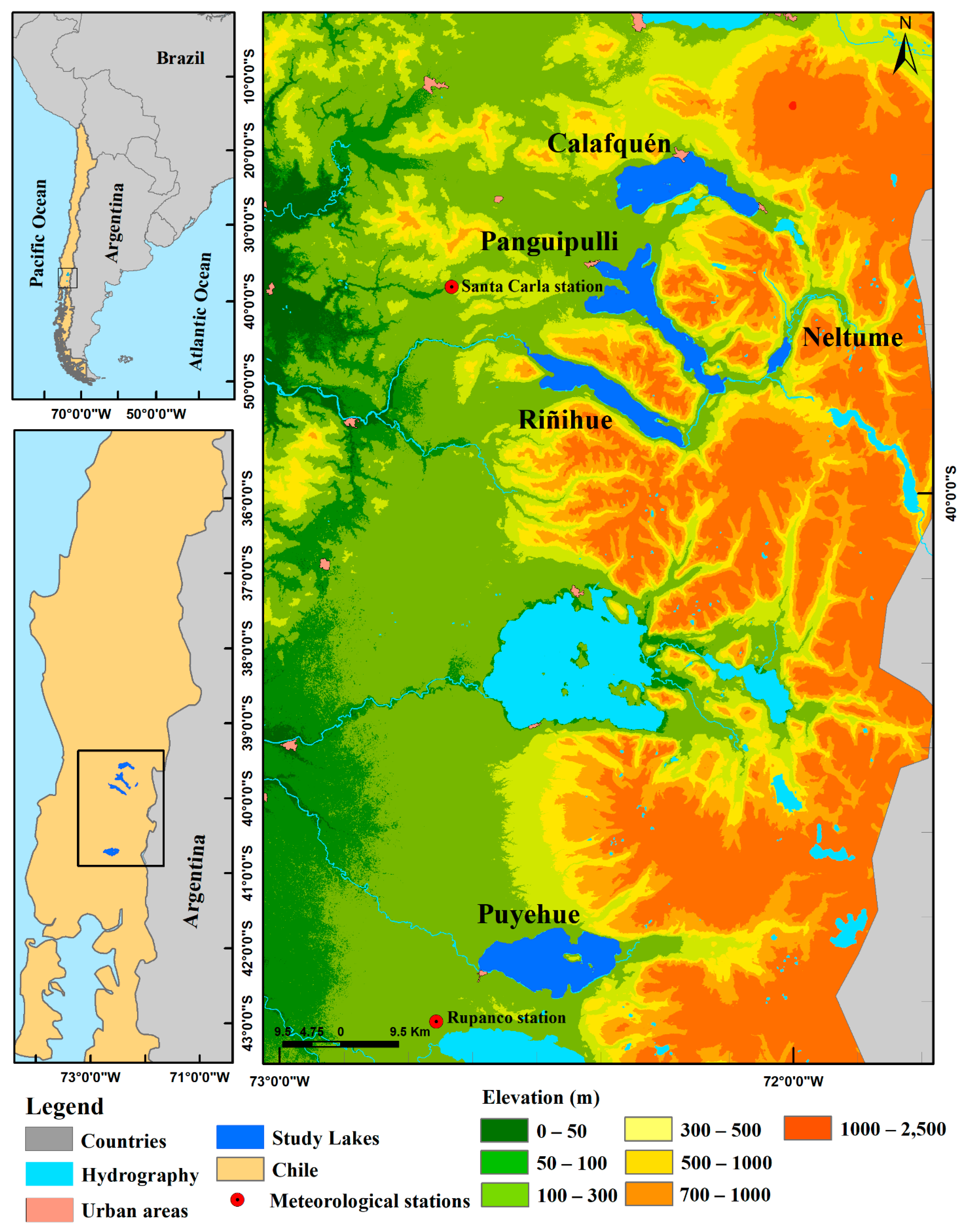
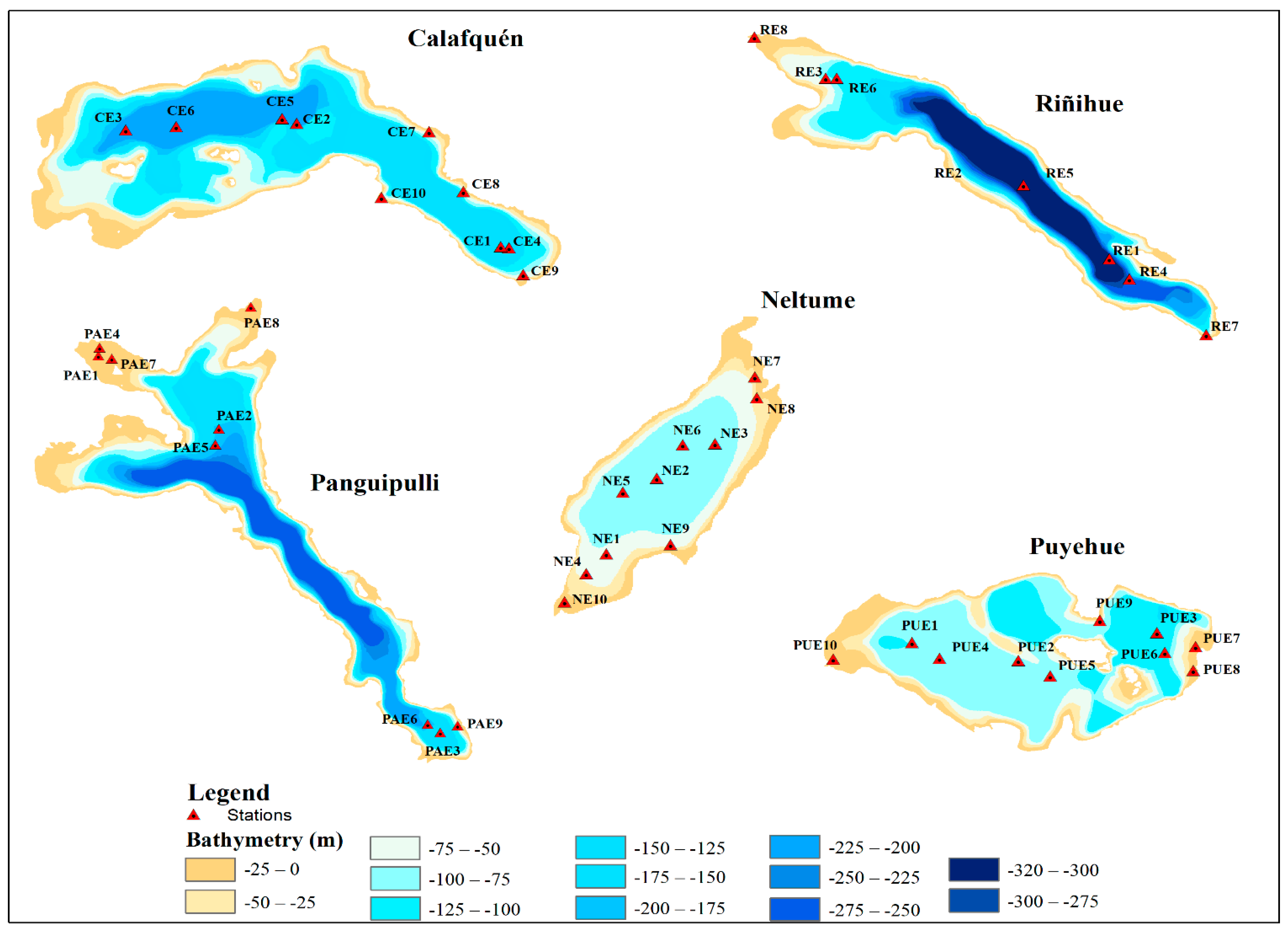

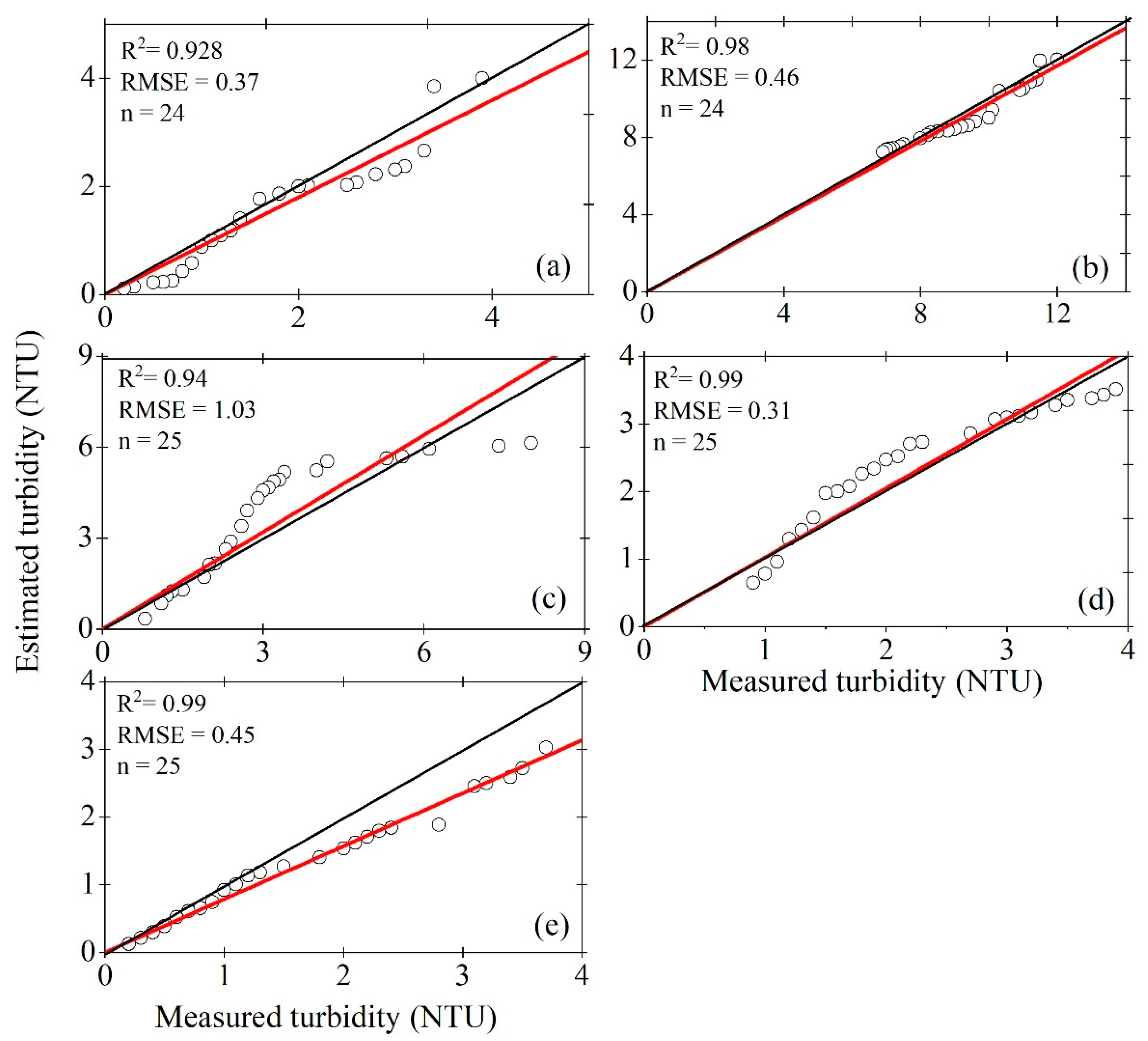
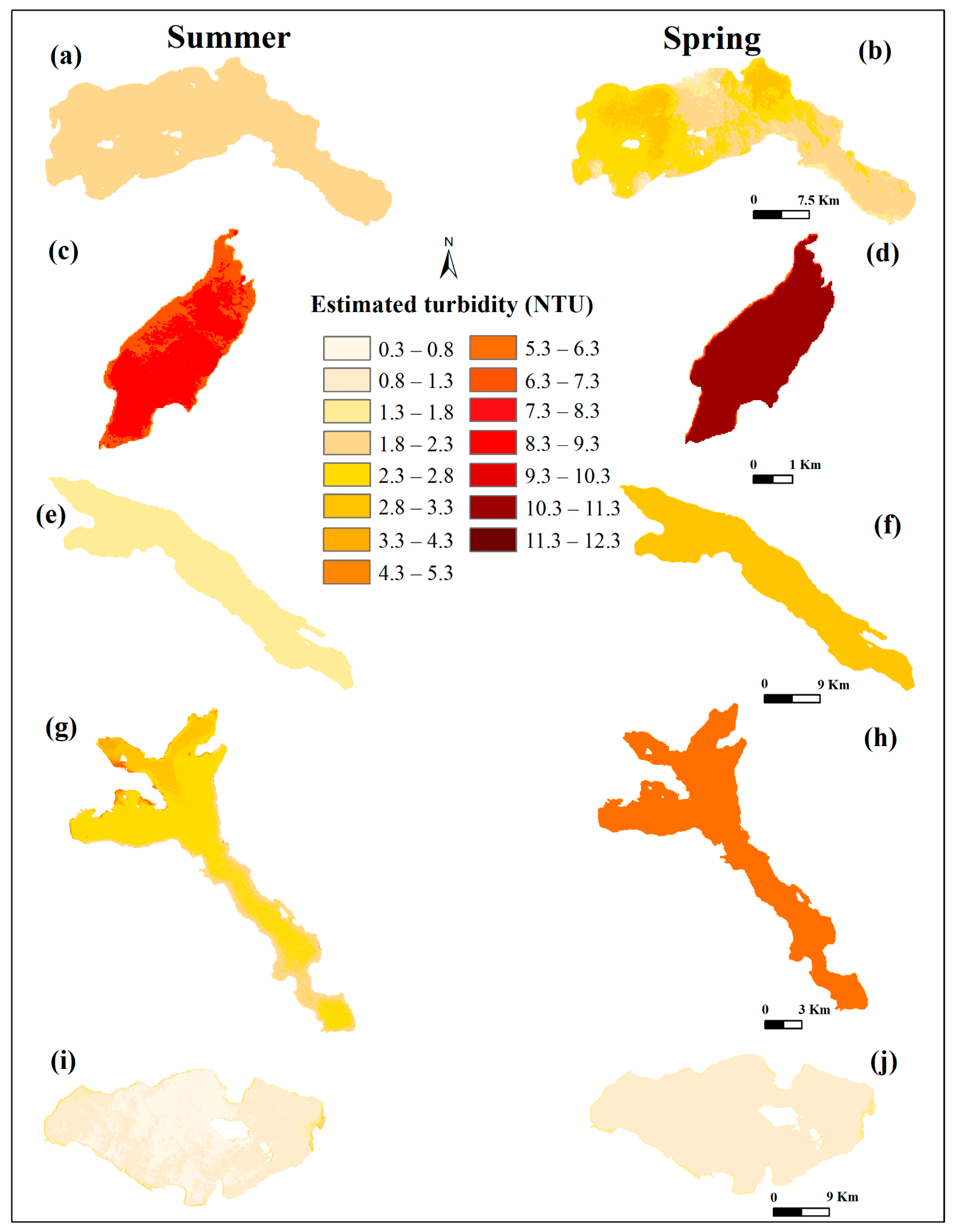
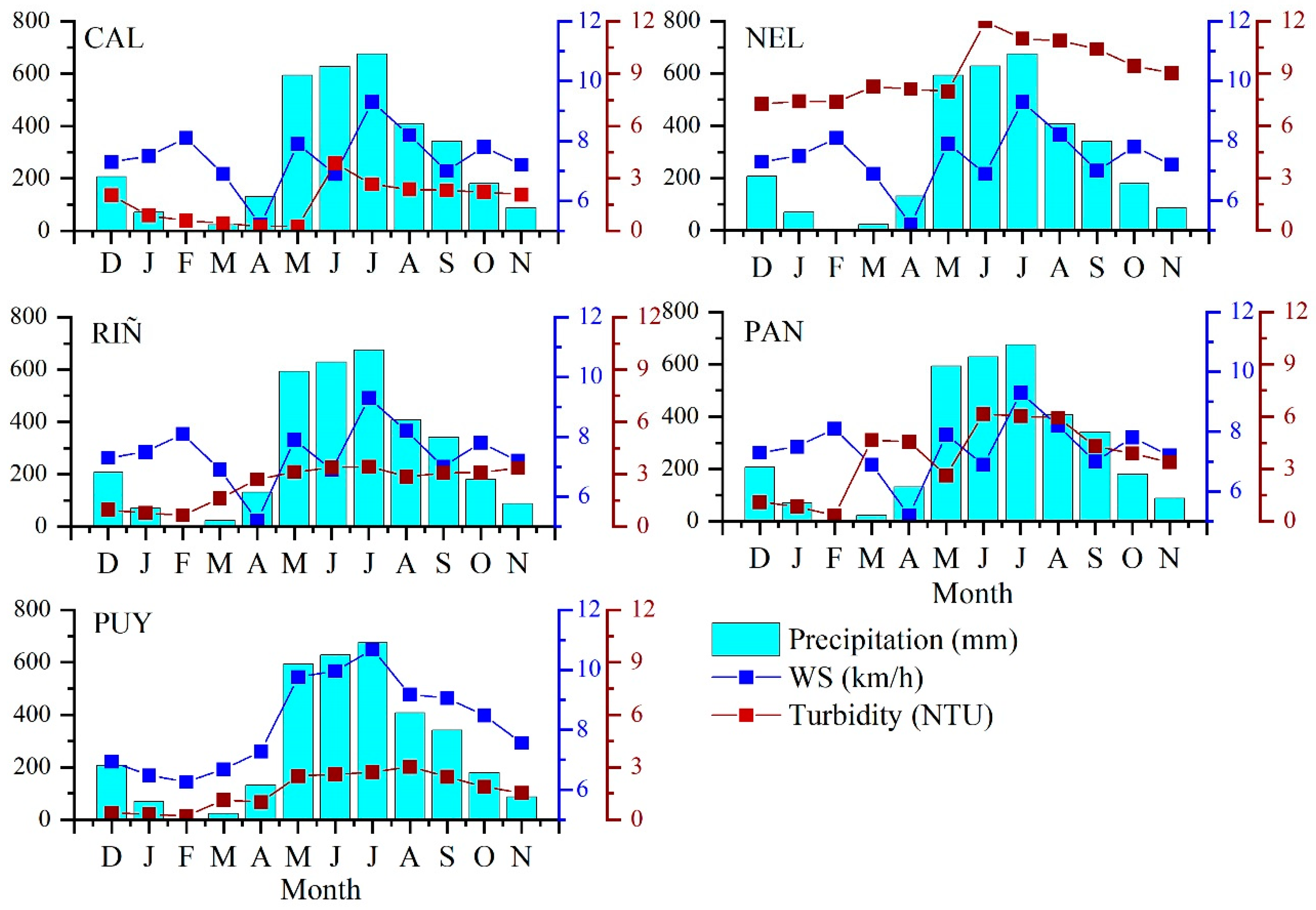
| Parameters | Unit | Calafquén | Neltume | Riñihue | Panguipulli | Puyehue |
|---|---|---|---|---|---|---|
| Latitude | ° ′S | 39.32 | 39.47 | 39.50 | 39.43 | 40.40 |
| Longitude | ° ′W | 72.09 | 71.58 | 72.20 | 72.13 | 72.28 |
| Altitude | m.a.s.l. | 203 | 186 | 117 | 140 | 184 |
| Long maximum | km | 25.10 | 6.30 | 27 | 28.30 | 23.50 |
| Maximum width | km | 7.80 | 2.40 | 5 | 9.70 | 11.30 |
| Medium width | km | 4.70 | 1.50 | 2.90 | 4.10 | 7.10 |
| Superficial area (A) | km2 | 120.60 | 9.80 | 77.50 | 116.90 | 165.40 |
| Maximum depth | m | 212 | 86 | 323 | 268 | 123. |
| Medium depth | m | 115 | 58 | 162 | 126 | 76.30 |
| Volume | km3 | 19.10 | 0.60 | 12.60 | 14.70 | 12.60 |
| Hydrographic basin area (Ad) | km2 | 733 | 763 | 4.290 | 1.51 | 1.53 |
| Ad/A | 6.10 | 77.90 | 55.35 | 32.60 | 9.10 | |
| Renovation time | years | 2.90 | 0.20 | 1.40 | 1.40 | 4.50 |
| Lake | Image ID | Path/Row | Year | In Situ Date | Image Date | Days Differences |
|---|---|---|---|---|---|---|
| Calafquén | LC82330872015028LGN01 | 233/87 | 2015 | 22 January | 28 January | ±6 |
| LC82320882015053LGN01 | 232/88 | 2015 | 27 February | 22 February | ±5 | |
| LC82320882015085LGN01 | 232/88 | 2015 | 18 March | 26 March | ±8 | |
| LC82330872015300LGN01 | 233/87 | 2015 | 23 October | 27 October | ±5 | |
| LC82330872015332LGN01 | 233/87 | 2015 | 3 December | 28 November | ±5 | |
| LT52330872011081COA00 | 233/87 | 2011 | 22 March | 22 March | ±0 | |
| Neltume | LC82320882015021LGN01 | 232/88 | 2015 | 20 January | 21 January | ±1 |
| LC82320882015053LGN01 | 232/88 | 2015 | 1 March | 22 February | ±7 | |
| LC82320882015085LGN01 | 232/88 | 2015 | 19 March | 26 March | ±7 | |
| LC82330882015300LGN01 | 233/88 | 2015 | 21 October | 27 October | ±6 | |
| LC82330872015332LGN01 | 233/87 | 2015 | 2 December | 28 November | ±4 | |
| LC82330882013278LGN01 | 233/88 | 2013 | 17 October | 5 October | ±12 | |
| Riñihue | LC82330882015028LGN01 | 233/88 | 2015 | 18 January | 28 January | ±10 |
| LC82330882015044LGN01 | 233/88 | 2015 | 25 February | 13 February | ±12 | |
| LC82320882015069LGN01 | 232/88 | 2015 | 17 March | 10 March | ±7 | |
| LC82330882015300LGN01 | 233/88 | 2015 | 19 October | 27 October | ±8 | |
| LC82330882015332LGN01 | 233/88 | 2015 | 30 November | 28 November | ±2 | |
| LT52330882011081COA00 | 233/88 | 2011 | 23 March | 22 March | ±1 | |
| Panguipulli | LC82320882015021LGN01 | 232/88 | 2015 | 19 January | 21 January | ±3 |
| LC82320882015053LGN01 | 232/88 | 2015 | 26 February | 22 February | ±4 | |
| LC82320882015085LGN01 | 232/88 | 2015 | 18 March | 26 March | ±8 | |
| LC82330872015284LGN01 | 233/87 | 2015 | 20 October | 11 October | ±9 | |
| LC82330872015332LGN01 | 233/87 | 2015 | 1 December | 28 November | ±3 | |
| LT52330882011081COA00 | 233/88 | 2011 | 22 March | 22 March | ±0 | |
| Puyehue | LC82330882015028LGN01 | 233/88 | 2015 | 24 January | 28 January | ±4 |
| LC82320882015069LGN01 | 232/88 | 2015 | 24 January | 10 March | ±14 | |
| LC82320882015085LGN01 | 232/88 | 2015 | 21 March | 26 March | ±5 | |
| LC82330882015300LGN01 | 233/88 | 2015 | 25 October | 27 October | ±2 | |
| LC82330882015332LGN01 | 233/88 | 2015 | 5 December | 28 November | ±7 | |
| LC82330882013134LGN02 | 233/88 | 2013 | 9 May | 14 May | ±5 | |
| LC82330882013278LGN01 | 233/88 | 2013 | 15 October | 5 October | ±10 |
| Parameters | Statistical Indicators | CAL | NEL | RIÑ | PAN | PUY |
|---|---|---|---|---|---|---|
| SDD | min–max (m) | 8.0–17.0 | 2.3–14.5 | 6.5–15.0 | 5.2–16.0 | 2.5–10.4 |
| Average ± σ | 11.9 ± 5.8 | 8.2 ± 3.8 | 10.5 ± 2.7 | 9.4 ± 3.7 | 6.8 ± 2.8 | |
| CV (%) | 48.8 | 45.6 | 26.0 | 39.7 | 40.9 | |
| n | 43 | 43 | 42 | 42 | 43 | |
| Chl-a | min–max (μg/L) | 0.1–2.6 | 0.1–0.7 | 0.1–1.1 | 0.1–1.4 | 0.1–2.7 |
| Average ± σ | 0.8 ± 0.6 | 0.3 ± 0.1 | 0.5 ± 0.2 | 0.5 ± 0.3 | 0.5 ± 0.2 | |
| CV (%) | 89.2 | 54.3 | 76.6 | 80.0 | 43.0 | |
| n | 42 | 42 | 42 | 42 | 43 | |
| Turbidity | min-max (NTU) | 0.2–3.9 | 6.9–12.0 | 1.0–3.9 | 1.1–8.0 | 0.3–3.7 |
| Average ± σ | 1.8 ± 1.1 | 9.2 ± 1.6 | 2.3 ± 0.9 | 3.4 ± 1.9 | 1.5 ± 1.0 | |
| CV (%) | 62.3 | 17.5 | 39.8 | 56.2 | 60.5 | |
| n | 25 | 25 | 25 | 25 | 25 | |
| Temp | min–max (°T) | 10.0–21.7 | 7.1–25.9 | 8,6–20.7 | 7.3–24.6 | 9.4–22.5 |
| Average ± σ | 15.7 ± 0.7 | 14.9 ± 5.6 | 15.4 ± 4.1 | 16.1 ± 4.4 | 14.9 ± 4.6 | |
| CV (%) | 4.3 | 37.5 | 26.6 | 27.5 | 30.7 | |
| n | 43 | 43 | 42 | 42 | 43 | |
| CV—coefficient of variation, n—data number, and σ—standard deviation | ||||||
| Lake | Relations | r | R2 |
|---|---|---|---|
| Calafquén | NTU = −0.30 SDD + 5.15 | −0.99 | 0.98 |
| Neltume | NTU = −0.39 SDD + 12.96 | −0.97 | 0.94 |
| Panguipulli | NTU = −0.51 SDD + 9.00 | −0.92 | 0.85 |
| Riñihue | NTU = −0.26 SDD + 5.19 | −0.95 | 0.91 |
| Puyehue | NTU = −0.44 SDD + 4.79 | −0.99 | 0.98 |
| Lake | Best Model | R2 | RMSE (NTU) | IA | MBE (NTU) |
|---|---|---|---|---|---|
| Calafquén | NTU = −107.06 (R + N) + 5.42 | 0.93 | 0.37 | 0.85 | −0.22 |
| Neltume | NTU = 7.34 (G/N) + 2.16 | 0.98 | 0.46 | 0.96 | −0.21 |
| Panguipulli | NTU = 6.98 (G/N) − 2.69 | 0.94 | 1.03 | 0.92 | 0.44 |
| Riñihue | NTU = −10.78 (R) + 3.21 | 0.99 | 0.31 | 0.97 | 0.12 |
| Puyehue | NTU= −2.70 (B/G) + 4.43 | 0.99 | 0.45 | 0.95 | −0.36 |
Publisher’s Note: MDPI stays neutral with regard to jurisdictional claims in published maps and institutional affiliations. |
© 2021 by the authors. Licensee MDPI, Basel, Switzerland. This article is an open access article distributed under the terms and conditions of the Creative Commons Attribution (CC BY) license (https://creativecommons.org/licenses/by/4.0/).
Share and Cite
Rodríguez-López, L.; Duran-Llacer, I.; González-Rodríguez, L.; Cardenas, R.; Urrutia, R. Retrieving Water Turbidity in Araucanian Lakes (South-Central Chile) Based on Multispectral Landsat Imagery. Remote Sens. 2021, 13, 3133. https://doi.org/10.3390/rs13163133
Rodríguez-López L, Duran-Llacer I, González-Rodríguez L, Cardenas R, Urrutia R. Retrieving Water Turbidity in Araucanian Lakes (South-Central Chile) Based on Multispectral Landsat Imagery. Remote Sensing. 2021; 13(16):3133. https://doi.org/10.3390/rs13163133
Chicago/Turabian StyleRodríguez-López, Lien, Iongel Duran-Llacer, Lisdelys González-Rodríguez, Rolando Cardenas, and Roberto Urrutia. 2021. "Retrieving Water Turbidity in Araucanian Lakes (South-Central Chile) Based on Multispectral Landsat Imagery" Remote Sensing 13, no. 16: 3133. https://doi.org/10.3390/rs13163133
APA StyleRodríguez-López, L., Duran-Llacer, I., González-Rodríguez, L., Cardenas, R., & Urrutia, R. (2021). Retrieving Water Turbidity in Araucanian Lakes (South-Central Chile) Based on Multispectral Landsat Imagery. Remote Sensing, 13(16), 3133. https://doi.org/10.3390/rs13163133








